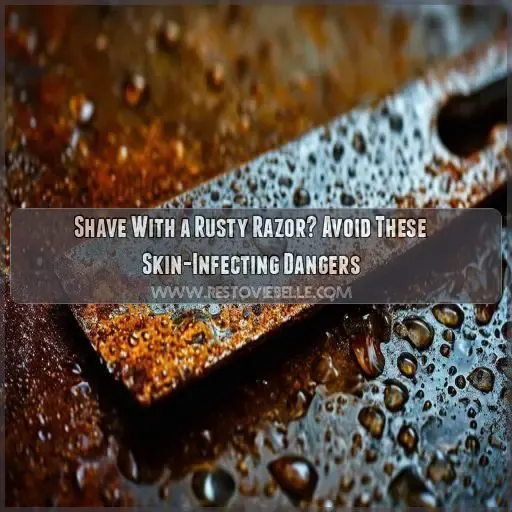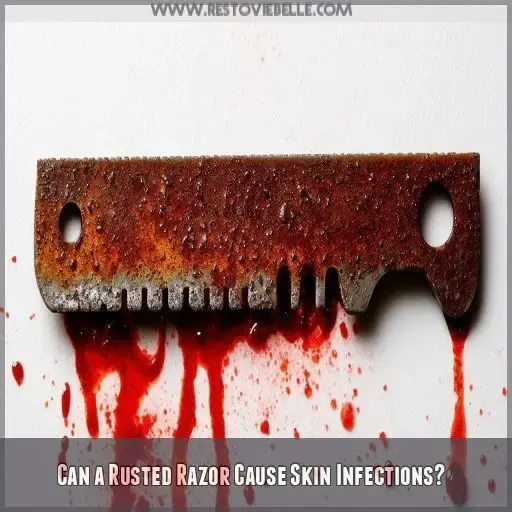This site is supported by our readers. We may earn a commission, at no cost to you, if you purchase through links.
 Shaving with a rusty razor is a bad idea.
Shaving with a rusty razor is a bad idea.
It’s a breeding ground for bacteria and fungi, which can lead to skin irritation, razor burn, ingrown hairs, and nicks and cuts that can get infected.
The dull blade will also give you a less-than-stellar shave.
To learn more about the dangers of rusty razors and how to keep your skin safe, keep reading.
Table Of Contents
- Key Takeaways
- Can a Rusted Razor Cause Skin Infections?
- What Happens When You Shave With a Rusty Razor?
- Recognizing Signs of Razor-Induced Infection
- Tips for Cleaning and Disinfecting Rusty Razors
- Preventing Infections From Rusty Razors
- Understanding the Dangers of Rusty Razors
- How to Properly Dispose of Rusty Razors
- Frequently Asked Questions (FAQs)
- Can You shave with a rusty razor blade?
- Can shaving with a rusty razor sabotage your skin health?
- How to shave a straight razor?
- Does a rusty razor make a difference?
- Is it bad to shave with a rusted razor?
- What happens if I shave with a dirty razor?
- Can a rusty razor cause an infection?
- What to do if your razor is rusty?
- How often should I replace my razor?
- Whats the best way to store my razor?
- What are the signs I need a new razor?
- What are the risks of rusty razors?
- How do I dispose of a rusty razor?
- Conclusion
Key Takeaways
- Rusty razors are a breeding ground for bacteria and fungi, leading to skin infections, irritation, and ingrown hairs.
- Shaving with a rusty blade can cause skin irritation, razor burn, and itchy, red skin due to its bluntness.
- Dull blades increase the risk of cuts and nicks, providing a gateway for bacteria and infections.
- Proper razor maintenance includes rinsing, drying, and regular replacement, storing it in a cool, dry place, and keeping tetanus shots up to date.
Can a Rusted Razor Cause Skin Infections?
You might be tempted to squeeze one more shave out of that old rusty razor, but hold up – there are some serious skin-infecting dangers lurking. We’re talking cuts, irritation, ingrown hairs, and even infections.
Let’s break down the risks and see why that rusty razor is a ticking time bomb for your skin.
Bacterial and Fungal Risks
You bet it can. Rusty razors are a breeding ground for bacteria and fungi, and shaving with one is like giving these nasties a free pass to your skin. Here’s why you should steer clear:
- Bacteria thrive on rusty surfaces.
- Fungi can grow on rusty blades.
- Cross-contamination is possible when sharing rusty blades.
Potential Complications
Rusty razors can cause a host of skin issues, including infections, razor burn, and ingrown hairs. While it’s unlikely to contract tetanus, the risk of bacterial and fungal infections is very real. Here’s a table highlighting some potential complications:
| Complication | Cause | Prevention |
|---|---|---|
| Razor Burn | Blunt blade | Replace blades regularly |
| Ingrown Hairs | Dull blade tugging at hair | Proper shaving technique |
| Skin Irritation | Bacteria, fungi | Disinfect razor |
| Bacterial Infection | Rusty blade | Keep tetanus booster up-to-date |
| Fungal Infection | Shared rusty blade | Avoid sharing razors |
What Happens When You Shave With a Rusty Razor?
Shaving with a rusty razor is a surefire way to invite a host of skin issues. From irritation and inflammation to the dreaded ingrown hairs, your skin will be crying out for help.
Let’s take a closer look at the specific dangers that lurk when you take that rusty blade to your skin.
Skin Irritation and Inflammation
Rusty razors can irritate your skin and leave it inflamed. The blunt blade tugs at your hair, causing razor burn and itchy, red skin. It’s like a double whammy of irritation, leaving your skin feeling tender and looking angry.
Risk of Ingrown Hairs
Shaving with a rusty razor can lead to a whole host of skin issues, including ingrown hairs. Ingrown hairs occur when the hair follicle curls down and grows into your skin instead of out and away from it. This can happen when a razor is blunt and tugs at the hair, causing trauma to the skin. Here are three things to keep in mind:
- Increased Risk: Rusty razors can increase the likelihood of ingrown hairs, especially if you make multiple passes.
- Skin Trauma: The blunt blade can cause micro-injuries, making it easier for hair to grow inward.
- Infection Risk: Ingrown hairs can become infected, leading to further skin issues.
Recognizing Signs of Razor-Induced Infection
Shaving with a rusty razor can lead to skin infections, but how do you know if you’ve got one? It’s not always easy to tell, but there are some tell-tale signs to watch out for.
Let’s take a closer look at the symptoms of a razor-induced infection and find out when it’s time to call the doctor.
Symptoms of Infection
If you’ve shaved with a rusty razor, keep an eye out for these signs of infection:
| Symptom | Description |
|---|---|
| Redness | Skin may appear red, irritated, and inflamed. |
| Itchiness | An itchy sensation can indicate the presence of razor burn or an infection developing. |
| Bumps | Small, red bumps may appear, similar to razor burn or acne breakouts. |
| Swelling | Look for any signs of swelling or fluid accumulation. |
When to Seek Medical Attention
While shaving mishaps are common, knowing when to handle things yourself and when to seek professional help is key to keeping your skin healthy and happy.
If you notice any of the following, it’s time to hang up the towel and consult a doctor:
- Redness, swelling, or tenderness around the affected area that doesn’t improve or worsens over time.
- Discharge of pus or fluid from the wound, especially if it has a foul odour.
- Fever, chills, or other flu-like symptoms that accompany the skin irritation.
- Persistent pain or discomfort that interferes with your daily activities.
- Any signs of infection that don’t respond to basic first aid measures, such as cleaning the area and applying over-the-counter antibiotics.
Tips for Cleaning and Disinfecting Rusty Razors
So, you’ve spotted some rust on your trusty razor and are wondering if it’s still safe to use.
Hold off on that shave for now. Rusty razors can harbor bacteria and fungi, leading to skin infections and irritation.
But don’t fret – we’ve got some essential cleaning and disinfecting tips to keep your razor in tip-top shape and your skin safe from harm.
Proper Razor Maintenance
Proper razor maintenance is key to avoiding skin infections and irritation. Here are some tips to keep your razor in tip-top shape:
- Rinse and dry: Always rinse your razor after each use and give it a good pat down with a towel to remove any excess moisture.
- Store it right: Make sure to store your razor in a cool, dry place. Humidity isn’t good for razor maintenance.
- Replace regularly: Don’t wait until your razor is rusty to replace it. For the best results, replace your razor blade every 5-10 shaves.
Disinfection Techniques
Keeping your razor clean is essential for hygiene and safety. Here are some tips for proper disinfection:
- Rubbing Alcohol: Soak your razor in rubbing alcohol for a few minutes, then rinse it with warm water.
- White Vinegar: Vinegar is a natural disinfectant. Soak a cotton ball in white vinegar and use it to wipe down your razor, removing any rust or debris.
- Rinse and Dry: Always rinse your razor with warm water after each use and let it air dry.
- Razor Case: Store your razor in a dry, sterile case to keep it clean and protected.
Preventing Infections From Rusty Razors
Shaving with a rusty razor can be a risky business, exposing your skin to bacteria and fungi that cause infections. In this section, we’ll arm you with the knowledge to prevent these infections and keep your skin healthy. From simple maintenance tips to understanding infection signs, you’ll learn how to navigate the dangers of a rusty razor.
Precautionary Measures
- Practice good razor hygiene: Keep your razor clean and dry after each use. Rinse it with warm water and gently pat it dry with a clean towel. Avoid rubbing it on a sponge or towel, as this can damage the blade.
- Regularly replace your blades: Dull blades are more likely to cause nicks and cuts, increasing the risk of infection. Replace your blades every 5–10 shaves, or more frequently if needed.
- Store your razor properly: Invest in a good razor holder to keep your razor dry and protected when not in use. Store it in a cool, dry place, away from humidity.
Tetanus Prevention
Now, let’s talk about tetanus prevention. While it’s unlikely you’ll get tetanus from a rusty razor, it’s still a good idea to take some simple precautions. First, make sure your tetanus shots are up to date. Get a booster every 10 years. If you get a deep cut, go to the doctor. They might give you antibiotics.
Understanding the Dangers of Rusty Razors
Shaving with a rusty razor might seem like a harmless shortcut, but it can lead to some serious skin issues. From skin irritation and ingrown hairs to bacterial and fungal infections, you’re signing up for a world of hurt.
Rusty razors are a one-way ticket to skin city, and not in a good way. Let’s explore the dangers and understand why it’s time to ditch that rusty blade for good.
Effects on Shaving
Shaving with a rusty razor can have some unpleasant consequences for your skin. Here are some of the effects you might experience:
- Skin irritation and razor burn: Rusty blades can cause red, itchy, and inflamed skin due to their bluntness, leading to an uneven shave.
- Ingrown hairs: The dull blade tugs at your hair, causing it to curl down and grow into your skin. This can lead to painful bumps and further irritation.
- Cuts and nicks: Rusty razors increase the risk of cutting your skin, and these wounds can become a gateway for bacteria and infection.
- Bacterial and fungal infections: Bacteria and fungi thrive on rusty surfaces, and using a rusty blade can introduce these microorganisms to your skin, increasing the chances of infection.
- Acne breakouts: The combination of skin irritation and bacterial growth can result in acne flare-ups, leaving your skin inflamed and bumpy.
Skin Health Complications
Rusty razors are a one-way ticket to skin irritation and infection city. They cause razor burn, leaving your skin itchy and red, and they also increase the chances of ingrown hairs. And let’s not forget the potential for bacterial or fungal infections, which can lead to some serious skin health complications. It’s a hard pass on rusty razors, folks.
How to Properly Dispose of Rusty Razors
Now that you understand the dangers of rusty razors, it’s time to talk about proper disposal. You wouldn’t want to accidentally cut yourself or someone else with a rusty blade, and you certainly don’t want to contribute to environmental harm. So, here’s how to safely get rid of those old razors:
- Don’t throw them loose in the trash. Rusty razors are sharp and can injure people handling the trash.
- Recycle responsibly. Contact your local waste management company to find out if they accept razor blades for recycling. Some communities have specific programs for sharps disposal, including razors.
- Use a blade bank. Consider investing in a blade bank, a small container designed to store used blades safely. Once full, recycle the entire thing.
- Create your own blade bank. If you can’t find a blade bank to buy, make your own! Get an empty metal container, like a tin can. Cut a narrow slot in the lid, tape over it securely, then drop in your used blades. When full, clearly label it "Razor Blades – Handle with Care" before disposing of it with recyclables.
- Disinfect before disposal. Before tossing your old razor, give it a final clean. Soak the blade in rubbing alcohol or a disinfectant to kill germs.
Frequently Asked Questions (FAQs)
Can You shave with a rusty razor blade?
You might be tempted to roll the dice with a rusty razor, but it’s a gamble that could leave you with skin irritation, infections, and ingrown hairs. It’s not worth the risk—swap that blade ASAP.
Can shaving with a rusty razor sabotage your skin health?
Yes, it can. You could end up with infections, skin irritation, and ingrown hairs.
How to shave a straight razor?
First, lather up with shaving cream. Grip the metal part of the blade, holding it at a 30-degree angle to your skin. Pull your skin taut with your free hand and drag the razor downward, shaving with the grain.
Does a rusty razor make a difference?
Rusty razors are dull, so you’ll need to apply more pressure. This increases the risk of cuts and nicks, skin irritation, and infection. Don’t risk it—change your blade regularly and store razors in a dry place.
Is it bad to shave with a rusted razor?
Yes, it’s bad to shave with a rusty razor. It’ll irritate your skin, cause infections, and won’t give you a smooth shave. It’s a lose-lose situation.
What happens if I shave with a dirty razor?
Think of a dirty razor like a paintbrush. If it’s caked with old paint, it’ll leave a mess. Shaving with a dirty razor can irritate your skin, cause razor burn, bumps, and even spread infections.
Can a rusty razor cause an infection?
Yes, rusty razors can cause infections. The environment that causes rust is also ideal for bacteria to thrive. Shaving with a rusty razor can cause small nicks, allowing bacteria to enter your bloodstream.
What to do if your razor is rusty?
If your razor is rusty, it’s time for a new one. But if you’re determined to save it, scrub with a paste, then rinse and dry. Soak in vinegar and baking soda. But beware: rust spreads, so get it all.
How often should I replace my razor?
You should replace your razor blade after 5-10 shaves. This keeps it sharp and free of bacteria, reducing the risk of skin irritation and infection.
Whats the best way to store my razor?
Keep your razor in a cool, dry spot, like a bathroom cabinet. Steer clear of humid places like the shower or tub.
What are the signs I need a new razor?
You need a new razor when you experience skin irritation, a less close shave, patchy areas, or a rough feel. Your razor may also be past its best if you feel hairs are being pulled, rather than cut.
What are the risks of rusty razors?
Rusty razors can cause skin infections, irritation, and increase the risk of bacterial and fungal growth. They may also lead to cuts and ingrown hairs.
How do I dispose of a rusty razor?
Wrap your rusty razor in duct tape, paper, cardboard, or a magazine cover. Label the package clearly with "SHARPS" or "USED RAZOR BLADES." Then, put it in the trash.
Conclusion
So, is shaving with a rusty razor a good idea?
Absolutely not.
Think of it like this: you wouldn’t cook with a rusty knife, so why risk it with your razor? It’s a one-way ticket to skin irritation, infection, and a less-than-perfect shave. Keep your blades fresh and clean, and you’ll keep your skin happy and healthy. Remember, a little care goes a long way in your shaving routine and your skin will thank you for it.













